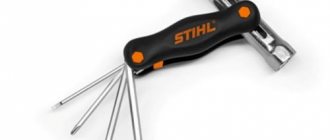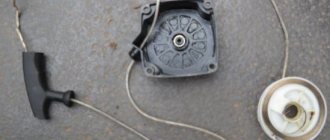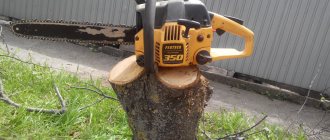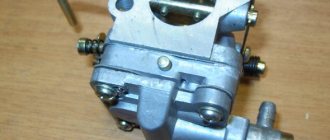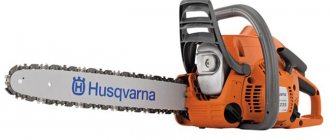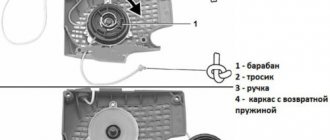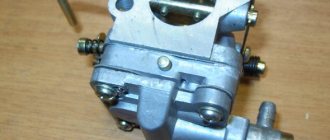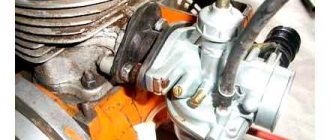How to clean a chainsaw
? The question for the owners of these instruments is by no means an idle one. Gasoline saws under the Shtil, Partner or Goodluck brands are not cheap. Yes, the downside of such high prices is the exceptional reliability of their mechanisms.
But no matter how reliable the mechanism is, if you don’t take care of it, clean it and lubricate it, it will definitely fail. And this statement fully applies to chainsaws.
They work in fairly harsh conditions. A gasoline engine constantly experiences overloads during operation associated with maintaining a given speed when cutting wood. A chainsaw creates a cloud of wood dust around itself, which inevitably settles not only on the body, but also on the internal components of the mechanism.
All this makes it necessary to regularly clean the chainsaw. And if this requirement is not met, you will need, which you can also purchase in our online store.
How should chainsaws be cleaned?
Cleaning chainsaws
produced both as a whole and by its individual mechanisms. In the first case, the body of the chainsaw and all its surfaces are cleaned from wood dust and other dirt adhering to them. It is advisable to carry it out regularly, immediately after completion of the work performed.
But regular cleaning still does not eliminate the need to clean its most important components and mechanisms, among which the most vulnerable are the filter, carburetor and muffler.
Given the difficult conditions in which chainsaws have to work, filters are the most important element for them. They keep the engine lubricant clean, which means they protect it from breakdowns.
Depending on the degree of contamination of the filter, it can be cleaned by blowing or washing in soapy water. For better purging, you should purchase a can of compressed air designed for cleaning the carburetor. With this can you simply blow out the air filter from the inside. A stream of compressed air will not only free the filter mesh from dust and dirt, but also from the moisture inside the cells.
You need to clean the chainsaw filter every time you finish working with it. And it doesn’t matter how long you worked with her - at least half an hour, at least a few hours.
If the filter is heavily soiled with any oily substances or dirt, it should be washed in soapy water. Instead of soap, you can take ordinary dishwashing detergent, for example, the same “Gala”.
Cleaning the carburetor is a more complex procedure than cleaning the filter. Often, owners remember about cleaning this device only when the chainsaw refuses to work: after turning it on, it immediately stalls. This means that the carburetor is completely dirty!
To clean it, the carburetor is removed from the chainsaw body and disassembled. After disassembly, you will most likely find that the sump is full of debris and the membranes are clogged with oily dirt.
If the contamination is not so critical, then the carburetor can be cleaned by blowing with compressed air. To clean membranes from dirty oil, you can use the Liquimoli universal cleaner or take the Verilub cleaner from XADO. In principle, there are now many similar cleaners in stores, and therefore their specific name is not so important.
In case of very heavy contamination, the cleaning procedure will be as follows:
- Using a stiff brush, clean the place where the carburetor is installed, including the niche where it is inserted, from dust and dirt;
- If there is an oily film on the surface of the carburetor and the chainsaw body, it can be removed with a clean, dry cloth;
- Membranes are cleaned with universal cleaners;
- The carburetor is washed in soapy water to clean its internal surfaces from oil and dirt.
After completing all these procedures, the carburetor is assembled and installed in its place.
Cleaning the muffler is also an important procedure, which will directly determine how comfortable it will be to work with a chainsaw. Carbon deposits may form on this mechanism, which is caused by low-quality engine oil or an incorrectly configured carburetor. Due to very thick carbon deposits, the chainsaw may stall or not start at all.
The method of cleaning the muffler from carbon deposits will depend on whether it is dismountable or not. In the first case, it is disconnected from the chainsaw and the carbon deposits are cleaned off with a stiff brush and then treated with fine sandpaper.
If your chainsaw has a non-separable muffler, then cleaning it from carbon deposits will be somewhat more difficult. On the Internet you will find a lot of advice on how to perform this procedure, from quite simple ones, for example, treating the muffler with acetone, to very exotic ones, for example, using fine shot for this purpose. But we recommend using special cleaning products.
When operating a tool such as a chainsaw, its owner often faces a number of problems, one of which is a clogged carburetor. This can happen if the chainsaw is filled with low-quality gasoline or foreign debris gets into the fuel tank. In order to clean the carburetor of a chainsaw, you must first disassemble it.
User reviews
For informational purposes, we provide examples of real reviews left by visitors through the comment form.
Review from Evgeniy: “What I really liked is that the chainsaw starts without any effort. You just have to pull. He saws quite quickly. The diameter of the log is up to 40 cm easily. At this price, it’s an absolutely indispensable device in my garden.”
Review from Maxim: “The quality of the plastic could be better. But this is a question for the manufacturer, not for the designers. There are no big complaints. The unit works well. In general, the price is really reasonable.”
Cleaning correctly
To properly clean your chainsaw, you will need the following tools:
- Phillips and flat screwdriver,
- wrenches with heads of different sizes,
- special cleaning composition, cleaning cloth,
- ultrasonic cleaner.
The set of tools can be seen in the photo.
Cleaning the carburetor of a chainsaw should be done according to the following algorithm:
- First you need to drain the remaining fuel from the fuel tank. Remove the cover of the chainsaw by unscrewing the fasteners. We take out the filter and disassemble the housing, removing nuts and clamps if necessary.
- Remove the fuel mixture supply hose from its clamp, unscrew the fasteners of the carburetor top cover. Then remove the top cover and the blue gasket - this is the fuel pump membrane. To the left of the body there are spring clips, remove them, and then the screws. It is advisable to label the parts and schematically record the places from which they were removed, so as not to confuse anything during assembly.
- Remove the bottom carburetor cover, unscrew the screw and remove the needle valve and the spring under it. Then, using longitudinal force, remove the air damper and its axis.
- Remove the throttle valve, drive lever and throttle shaft.
- We lay out all the removed carburetor parts on a flat surface and inspect them to ensure integrity is maintained. Parts with a high degree of wear must be replaced with new ones.
- Using a specialized cleaning agent, wash the parts and dry with a lint-free cloth. The tubes must be blown under pressure using a pump.
- To achieve maximum effect, you can clean the carburetor on a Shtil chainsaw using a special cleaning bath, the basis of which is the cavitation effect. The bath is filled with diesel fuel, and the carburetor parts are immersed in it for several minutes. Finally, we dry the parts using a pump.
A detailed video with the cleaning process will help you do the job correctly.
After all the products have been dried, it is necessary to assemble the carburetor. Usually the detergent evaporates completely within a day. It is better to wait a day after cleaning, since residual detergents on the parts can get into the fuel compartment and release toxic gases during combustion.
Another important nuance associated with disassembling a chainsaw is that it is necessary to extremely accurately install and adjust the needle valve blade, otherwise the chainsaw may not start. You can use a blade to check that the petal is installed correctly. Having installed it on top, we see how freely the petal rotates. If no problems arise, then everything is in order and you can continue assembly. If movement problems still arise, then the petal must either be pressed down or the edge on it must be bent.
How to clean a chainsaw filter
It may be necessary to clean the Husqvarna chainsaw filter after each use. The cleaning process itself, depending on how dirty the filter is, can be done in two ways:
- A mechanical cleaning method, which involves blowing the filter.
- For higher degrees of contamination, the filter is washed in soapy water.
Important! It is forbidden to wash the filter in aggressive solutions: gasoline, diesel fuel, acetone.
How to clean a muffler on a chainsaw
Timely measures to clean the chainsaw muffler can significantly extend the life of the tool. There are several reasons for muffler contamination:
- long service life,
- low quality of the oil being poured,
- Incorrect carburetor settings.
To check the condition of the muffler, you need to dismantle it and look inside. If you need to remove the muffler on a Stihl chainsaw, you need to remove the muffler fasteners, the muffler itself, the plate and the reflector.
If you find carbon deposits inside the muffler, then this problem can be solved in two ways:
- Mechanical method (cleaning is carried out using brushes, sandpaper and special products). This path is possible if the muffler is disassembled.
- In the case of a non-removable muffler, special cleaning compounds are used in which the muffler is soaked for several hours.
By performing all the steps correctly, you can easily clean your chainsaw, extend the life of the tool and protect yourself while working.
How to completely clean a chainsaw: carburetor, filter, muffler
During the operation of a tool such as a chainsaw, its owner often encounters a number of problems, one of which is a clogged carburetor. Description of adjustment and video example of a chainsaw just like European ones. Video. How to quickly clean a Stihl MS 180 chainsaw. This can happen if the chainsaw is filled with low-quality gasoline or foreign debris gets into the fuel tank. In order to clean the carburetor of a chainsaw, you must first disassemble it.
Tire care
They always forget to lubricate this crap
Every few hours of work, it is necessary to rearrange the tire 180° so that both sides are used approximately equally.
Also, every time you fill the tank, you need to lubricate the tire sprocket so that it serves for a long time and normally, for which almost all stores sell special syringes for lubricating the sprocket. The only manufacturer that has solved this issue is Stihl with its Ematic
Very often you can hear advice that if a “dented groove” forms on the guide runners, straighten it with a file, however, if the tire does not properly groove. Moreover, if you do not maintain an ideal right angle between the file and the bar, then the “corrected” bar will last even less, since during operation the chain will wobble in the runners and break them even more strongly.
Cleaning correctly
To properly clean your chainsaw, you will need the following tools:
- Phillips and flat screwdriver,
- wrenches with heads of various sizes,
- special cleaning composition, cleaning cloth,
- ultrasonic cleaner.
The set of tools can be seen in the photo.
Cleaning a chainsaw carburetor should be done using the following method:
- First you need to drain the remaining fuel from the fuel tank. Remove the cover of the chainsaw by unscrewing the fasteners. How to disassemble a chainsaw quickly and accurately? They need to be cleaned with emery cloth. We take out the filter and disassemble the housing, removing nuts and clamps as needed.
- Remove the fuel supply hose from its clamp, unscrew the fasteners of the carburetor top cover. Then we remove the top cover and the blue gasket - this is the fuel pump membrane. There are spring clips to the left of the body; remove them, and then the screws. It is better to label the parts and schematically record the places from which they were removed, so as not to confuse anything at the time of assembly.
- Remove the bottom cover of the carburetor, unscrew the screw and remove the needle valve and the spring under it. Then, using longitudinal force, remove the air damper and its axis.
- Remove the throttle valve, drive lever and throttle shaft.
- We lay out all the removed carburetor parts on a flat surface and inspect them to ensure integrity is maintained. You don’t know how to adjust and see a visual example in the chainsaw video. Parts with the highest degree of wear must be replaced with new ones.
- Using a special cleaning agent, wash the parts and dry with a lint-free cloth. The tubes must be blown under pressure using a pump.
- To achieve the greatest effect, you can clean the carburetor on a Shtil chainsaw using a special cleaning bath, the basis of which is the cavitation effect. The bath is filled with diesel fuel, and the carburetor parts are immersed in it for a couple of minutes. How to Clean a Chainsaw Partner. In this video I told you how to install a non-standard carburetor on a Friendship 4 chainsaw! Finally, we dry the parts using a pump.
How to properly clean a Stihl MS 180 chainsaw after use
Chainsaw cleaning question
Stihl MS 180 is very important after the work done.
Clean the
Stihl MS 180 chainsaw.
Detailed video
will help with the cleaning process to do the job correctly.
After all the products have been dried, it is necessary to assemble the carburetor. Usually the detergent evaporates completely within a day. You can clean your chainsaw. Detailed video with the cleaning process How to clean. Also at the end of the post I added a video on how to adjust the chainsaw according to. It is better to wait a day after cleaning, since residual detergents on the parts can get into the fuel compartment and release toxic gases during combustion.
Another important nuance associated with disassembling a chainsaw is that it is necessary to extremely accurately install and adjust the needle valve blade, otherwise the chainsaw may not start. You can use a blade to check that the petal is installed correctly. Having installed it on top, we see how freely the petal rotates. If no problems arise, then everything is in order and you can continue assembly. In this video I will show you how to properly install the ignition on a chainsaw and how to adjust the carburetor on a chainsaw. If movement problems still arise, then the petal must either be pressed down or the edge on it must be bent.
Gasoline leaks from the lawnmower carburetor into the air filter when idle
Adjusting the maximum speed
The maximum speed is adjusted using screw H. The speed increases when it is turned clockwise, and decreases when it is turned counterclockwise.
The highest rotation speed of chainsaw engines varies from 11,500 to 15,000 rpm. Higher speed can be dangerous for the engine and is simply not provided by the ignition. Therefore, the maximum speed can be determined by the occurrence of ignition interruptions. If they appear, turn screw H slightly counterclockwise.
Re-check at idle
After you have adjusted the acceleration and maximum engine speed, be sure to re-check the operation of the chainsaw at idle. When the carburetor is correctly adjusted, the following conditions must be met:
- at idle, the chain should not move;
- the engine should pick up speed quickly;
- The engine should operate like a four-stroke engine.
If the operation of the chainsaw does not meet at least one of these conditions, the adjustment procedure (except for the basic stage) will have to be repeated again.
How to clean a muffler on a chainsaw
Timely measures to clean the chainsaw muffler can significantly extend the life of the tool. There are several reasons for muffler contamination:
- long service life,
- low quality of the oil being poured,
- Incorrect carburetor settings.
Timely cleaning of the chainsaw will ensure a long service life of the tool. How often this procedure should be performed depends on the intensity of use.
Attention! Before you start cleaning the tool, you need to drain the fuel from the tank, remove the saw chain and place it in oil, and also check for possible damage.
According to service specialists, upon completion of work it is necessary to clean the main elements of the chainsaw:
- A chain brake that becomes contaminated during operation with sawdust, shavings and other debris will result in poor performance. This element is cleaned with kerosene.
- Air filter. The best way to clean chainsaw filters is to simply tap and blow. To remove more serious stains, we recommend first immersing the part in a container of non-flammable liquid detergent. Warm soapy water can be used. Before installation, the filter must be thoroughly dried. If the filter material is damaged, the corresponding elements must be replaced immediately.
Besides:
- Check the presence of oil, if it is empty, add to the required level. If the chain is loose, tighten it. If necessary, add the required amount of fuel mixture.
- The driven sprocket of the tire should be lubricated and immersed in heated oil after every hour of operation of the tool.
Lubricants
Anyone who is not an enemy of their chainsaw must understand once and for all that oil only exists in Russian sayings, and in chainsaws there is suitable and unsuitable oil. Everyone wants to save money, but by saving a few hundred rubles on motor oil (by buying not synthetics from a normal company for 500 rubles, but some Chinese junk for 200 rubles), you can kill a piston engine in a couple of hours of work, costing 80% of the cost of a chainsaw.
The same goes for chain and bar oil - the real savings when using bad oils are lower than the lost profits after the chain and bar fail.
In addition, for household use, even the most expensive oil is not an item for significant savings.
What else should you pay attention to when cleaning your chainsaw?
Remove dust from the cylinder windows, combustion chamber, piston grooves, rings and piston crown every 25 hours of operation. Clean the grooves of the guide bar - you can use a small screwdriver for this, and a wire for the oil holes.
If you notice that the performance of the tool has become lower, the muffler or fan disc may be clogged, clean it. From time to time we recommend turning the guide bar over and checking the sprocket and clutch. Exposed areas susceptible to corrosion should be lubricated with oil. If you plan to store the instrument for long-term storage, we recommend preserving it.
Online store “Buy for your dacha” - favorable conditions for every client!
Shopping with us is pleasant and profitable because we:
- We sell products whose quality is confirmed by certificates;
- we deliver goods to any point in the Russian Federation (more detailed information about the conditions for transporting equipment can be found on our website);
- We provide after-sales service and free pre-sale preparation.
It would seem, why does a summer resident who grows vegetables and fruits, or the owner of a country house with a small garden and several flower beds, need a chainsaw?
The question disappears when the desire arises to build a bathhouse, update a greenhouse, knock down an old business, or simply make a bench for relaxation. Unfortunately, any mechanism periodically needs maintenance and replacement of spare parts, and for this you need to have a good understanding of the structure of the product, besides, repairing a chainsaw with your own hands will save time and money.
Structural components of a chainsaw
All chainsaws are similar in structure, regardless of whether they are made in Europe (ECHO, Stihl, Husqvarna). Inside the body there are the main elements - the fuel tank and the engine, and outside there is a starter, a handle, a saw part (tire) with a chain. A sharp tug of the cable starts the engine, and it starts the saw blade.
From time to time, malfunctions occur in the operation of the saw, which require disassembly to eliminate. What can happen to such a simple mechanism as a chainsaw? At least the following:
- stops starting;
- starts but soon stops;
- stops functioning in cutting;
- loses its power;
- Most problems are associated either with interruptions in engine operation (fuel supply system, exhaust system, ignition, cylinder-piston part), or with malfunctions of other systems and components (clutch, chain brake, tire, lubrication system). Let's look at the most common breakdowns and methods for eliminating them.
Specifications
The Carver RSG 238 gasoline saw is equipped with a carburetor internal combustion engine (internal combustion engine) running on a fuel mixture that includes gasoline and semi-synthetic
oil intended for two-stroke internal combustion engines. The main technical indicators of the Carver RSG 238 chainsaw are the following characteristics:
- class - household chainsaw.
- engine power – 1.7 hp, or 1.2 kW;
- engine capacity – 38 cubic meters. cm;
- fuel tank volume – 0.47 l;
- oil tank volume – 0.2 l;
- tire length – 16″ (inches), or 40 cm;
- saw chain pitch – 3/8″ (inch);
- number of links – 57;
- saw groove width – 1.3 mm;
- weight – 5.8 kg;
- packaging dimensions – 430 x 250 x 300 mm.
Equipping the chainsaw with the QuickStart system allows you to compensate for engine resistance at the time of start-up. Compared to similar internal combustion engines, the Carver RSG 238 chainsaw engine reduces fuel consumption by 20% and increases power by 5%.
The Russian brand Carver is produced in China. Models are produced according to their intended purpose: household, semi-professional, professional.
Checking the ignition system
The first thing you need to do when your chainsaw breaks down is to inspect the spark plug by disconnecting the wire and carefully unscrewing it with a special wrench.
Her appearance speaks volumes:
- dry. Most likely, the fuel mixture is not getting into the cylinder. The problem is not in the ignition system, so the spark plug is screwed back in;
- heavily splashed with fuel. The reason for the excess fuel mixture lies either in violation of the starting rules or in incorrect carburetor adjustment. The spark plug is thoroughly wiped, the fuel supply is turned off and the starter is turned on to remove excess fuel and ventilate the combustion chamber. Then the candle is placed in place and the mechanism is started again;
- covered with black soot. This may indicate the use of low-quality oil, an incorrectly adjusted carburetor, or an incorrectly calculated ratio of gasoline to oil. The spark plug should be washed, removed from carbon deposits with a sharp object (an awl or a needle), the electrodes should be wiped with sandpaper and placed in place.
When checking the spark plug, you need to pay attention to the gap between the electrodes: 0.5 to 0.65 mm is considered normal. A damaged or worn gasket must be replaced.
To be completely sure, you should also check for a spark. To do this, put the ignition cable on the spark plug, connect the spark plug nut and the cylinder with pliers, turn on the starter and watch for the appearance of a spark. If it is missing, the spark plug needs to be replaced. If the new spark plug also does not produce a spark, the problem is in the high-voltage wire or in a broken connection to the spark plug.
Fuel supply system repair
Fuel may not enter the cylinder for the following reasons:
- fuel filter contamination. You should remove the fuel hose and check how the fuel flows. If the stream is weak, the filter may need to be cleaned. It is taken out through the filler hole of the fuel tank and cleaned; in case of severe contamination, it is replaced with a new one. As a preventative measure, it is recommended to replace the fuel filter once every three months;
- clogged breather (hole in the fuel tank cap). They also check by disconnecting the hose; if clogged, clean it with a needle;
- lack or insufficient amount of fuel. There may be several reasons for the malfunction. The first reason is a clogged air filter. Air stops flowing into the carburetor in the required quantity, and therefore, due to the fuel mixture being too rich, engine operation is disrupted. The dirty filter is carefully removed, cleaned and rinsed in water, then dried and replaced.
Another reason is improper carburetor adjustment. Adjustment is made with three screws.
During work, you must use the instructions, otherwise you can only make things worse.
And the last reason is a violation of the integrity of the membrane or clogging of the carburetor channels.
All parts must be clean, dry and in good working order.
Disassembling and cleaning the muffler
If the engine runs great at low speeds, but starts to stall at high speeds, the reason may lie in the muffler spark arrester, which is clogged with combustion products.
Procedure:
- remove the muffler;
- disassemble (there are also non-dismountable models);
- remove carbon deposits using detergents;
- dry with a hairdryer;
- install in place.
Dry cleaning is unacceptable, as carbon deposits contain carcinogens, the inhalation of which is hazardous to health. After removing the muffler, cover the exhaust hole with a clean rag.
To prevent clogging of the muffler, it is necessary to monitor the composition of the fuel mixture. The amount of oil should not exceed the standards recommended by the manufacturer. Poor oil quality also negatively affects engine performance.
Warnings
Bent or incorrectly installed rods, cables and wires when assembling the carburetor will certainly become the reason that will not allow the engine to start or the engine will run poorly (when disassembling the carburetor, you need to remember how the connections are so that they can also be put in place during reassembly).
The chainsaw carburetor is made of a relatively soft aluminum alloy and when tightening the screws, you can easily break the threads in the carburetor body (do not overtighten the fasteners so as not to break the threads).
Avoid contact with skin, contact with eyes, or inhalation of fuel vapors or carburetor cleaner (use rubber gloves).
Fire safety rules must be observed, since fuel...
Chainsaw care
Assessment of the condition of the cylinder-piston group
Often the engine does not start or does not operate at full capacity due to low pressure in the cylinder. It can be caused by wear of the piston or cylinder, stuck piston rings, or worn bearings. You can partially examine the condition of the cylinder-piston group (CPG) by removing the muffler and looking into the opened hole.
A compression gauge placed in the spark plug hole will help measure the compression in the engine - based on the measurement results, we can also talk about the condition of the CPG. Accurate data is obtained only after complete disassembly of the mechanism. If the piston is chipped or scratched, it needs to be replaced. The piston ring must be clean, free of carbon deposits, and be exactly in place.
Repairing the chain lubrication system
Let's look at three main faults:
- oil leakage. You should check whether the tubes are tightly connected to the pump fittings and whether there are any cracks on them. Problematic tubes are sealed with sealant or replaced;
- insufficient oil supply. Most likely, the lubricant supply channels are clogged;
- cracks in the oil pump housing. The part needs to be replaced.
Adjusting the chain brake The chain brake often does not work due to clogging of the brake band and the space under the cover with grease or sawdust. All parts should be cleared of blockages. Perhaps the tape is simply worn out, then it needs to be replaced.
Some parts of a chainsaw wear out faster than others. These include the drive sprocket, tire, chain, and anti-vibration elements. For quick replacement, it is better to always have spare parts on hand. Don't neglect sharpening the chain.
Video
| Chainsaws and accessories in Moscow, you can find out about the availability and price of a product by calling +7 To support the site, call it when calling or purchasing a product |
etc
Chainsaws
| Manufacturers | Stihl |
| Chains | Oregon • Stihl • Chain sharpening • Chain oil |
| Info | Gasoline-oil mixture • How to choose a chainsaw • How to work with a chainsaw • Working off • Caring for a chainsaw |
| How-Know | Chainsaw for women • Chainsaw chainsaw • Chinese chainsaw (Husqvarna / Shtil) • Four-stroke chainsaw |
| Chainsaws | |
